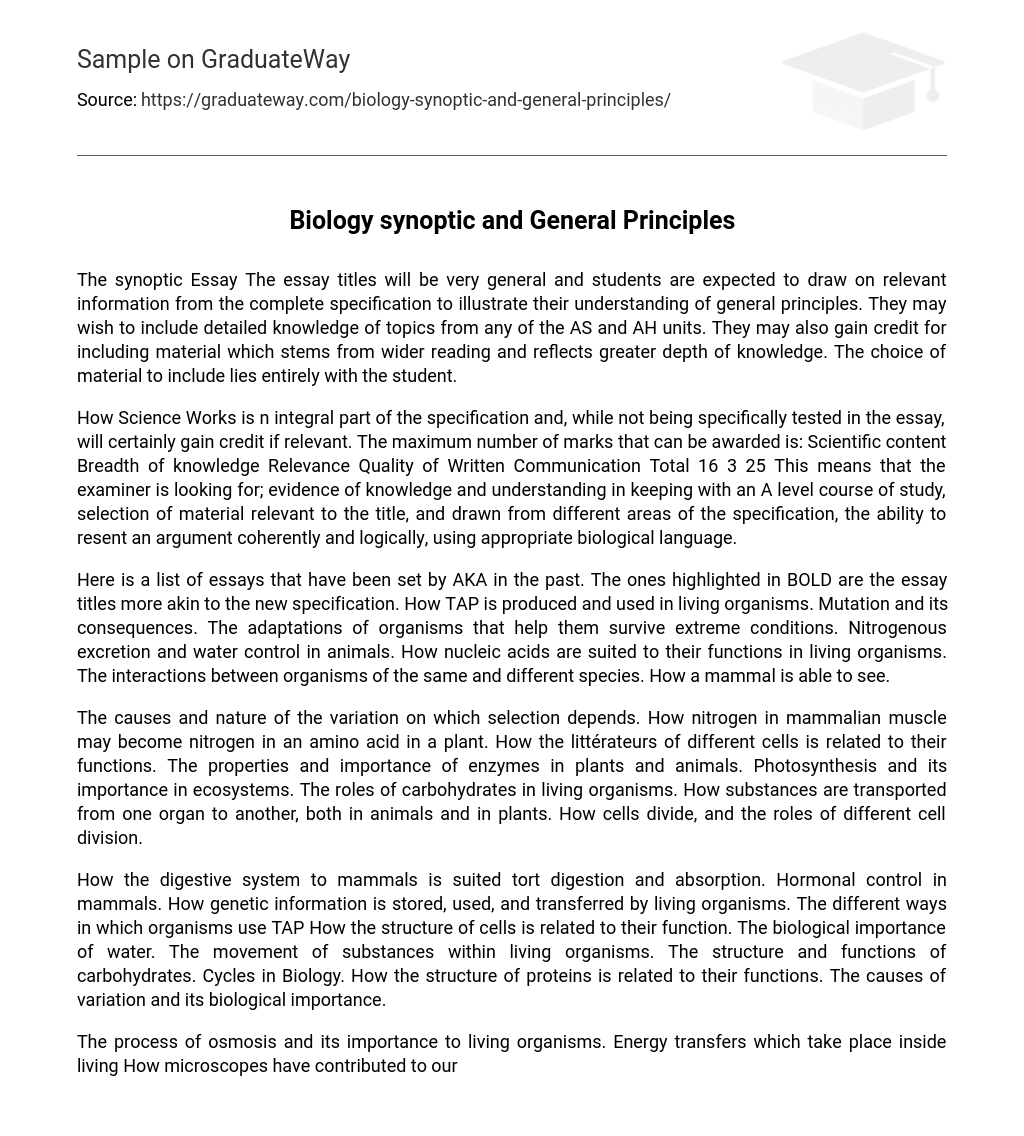The synoptic Essay The essay titles will be very general and students are expected to draw on relevant information from the complete specification to illustrate their understanding of general principles. They may wish to include detailed knowledge of topics from any of the AS and AH units. They may also gain credit for including material which stems from wider reading and reflects greater depth of knowledge. The choice of material to include lies entirely with the student.
How Science Works is n integral part of the specification and, while not being specifically tested in the essay, will certainly gain credit if relevant. The maximum number of marks that can be awarded is: Scientific content Breadth of knowledge Relevance Quality of Written Communication Total 16 3 25 This means that the examiner is looking for; evidence of knowledge and understanding in keeping with an A level course of study, selection of material relevant to the title, and drawn from different areas of the specification, the ability to resent an argument coherently and logically, using appropriate biological language.
Here is a list of essays that have been set by AKA in the past. The ones highlighted in BOLD are the essay titles more akin to the new specification. How TAP is produced and used in living organisms. Mutation and its consequences. The adaptations of organisms that help them survive extreme conditions. Nitrogenous excretion and water control in animals. How nucleic acids are suited to their functions in living organisms. The interactions between organisms of the same and different species. How a mammal is able to see.
The causes and nature of the variation on which selection depends. How nitrogen in mammalian muscle may become nitrogen in an amino acid in a plant. How the littérateurs of different cells is related to their functions. The properties and importance of enzymes in plants and animals. Photosynthesis and its importance in ecosystems. The roles of carbohydrates in living organisms. How substances are transported from one organ to another, both in animals and in plants. How cells divide, and the roles of different cell division.
How the digestive system to mammals is suited tort digestion and absorption. Hormonal control in mammals. How genetic information is stored, used, and transferred by living organisms. The different ways in which organisms use TAP How the structure of cells is related to their function. The biological importance of water. The movement of substances within living organisms. The structure and functions of carbohydrates. Cycles in Biology. How the structure of proteins is related to their functions. The causes of variation and its biological importance.
The process of osmosis and its importance to living organisms. Energy transfers which take place inside living How microscopes have contributed to our understanding of living organisms. Enzymes and their importance in plants and animals Negative feedback in living organisms Mean temperatures are rising in many parts of the world. The rising result in physiological and ecological effects on living temperatures may organisms. Describe and explain these effects. The transfer of substances containing carbon between organisms Cells are easy to distinguish by their shape.
How are the shapes of cells related to their function? Movements inside cells Transfers through ecosystems The part played by the movement of substances across cell membranes in the functioning of different organs and organ systems The part played by enzymes in the functioning of different cells, tissues and Ions and organisms organs DNA and the transfer of information The movement of substances within living organisms Cycles in Biology Titles suggested by AKA, for the new specification The ones highlighted in bold in the list above plus; How bacteria affect human lives
The ways in which different species of organisms differ from each other Describe how the structure of different polymers are related to their functions Why offspring produced by the same parents are different in appearance The importance of hydrogen bonding in living organisms Inorganic ions include those of sodium, phosphorous and hydrogen. Describe how these and other inorganic ions are used in living organisms Carbon dioxide may affect organisms directly or indirectly. Describe June 2010 and explain these effects. The causes of disease in humans.





